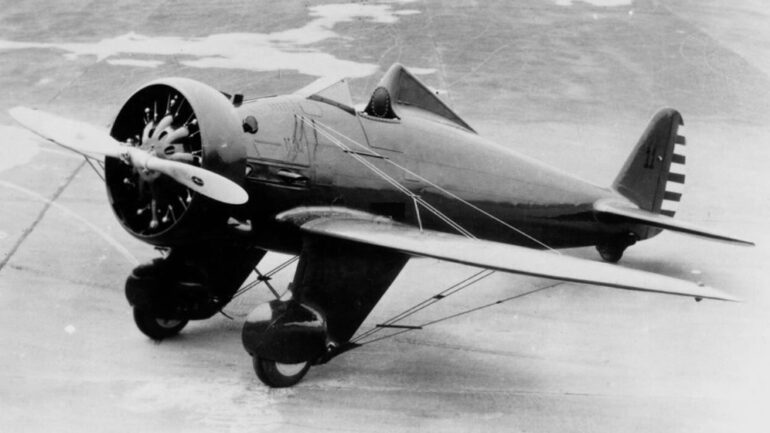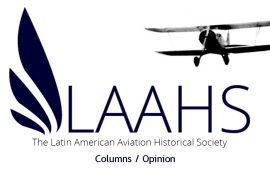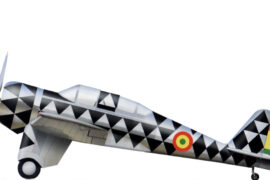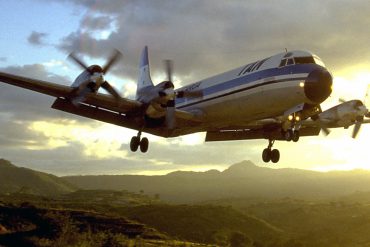At long last, the serious study of the aviation history of the region of our home planet that we sometimes describe as Latin America has coalesced and, in virtually every national entity in these boundaries, wonderful work is being accomplished – and not a moment too soon.
The “bully pulpit” and “center of gravity” of this effort has finally emerged in the form of the Latin American Aviation Historical Society (LAAHS), which has provided all of us an invaluable focal point to not only make compact and meaningful contributions on an astonishing array of very worthwhile subjects, but to serve as an exceptionally durable and even-handed forum. Long may it prosper and increase.
Between 1988 and 2008, your scribe had the high honor of serving as the Adjunct Curator for Latin American Aviation History at the National Air and Space Museum, Smithsonian Institution which, in itself, was a testimony that the NASM leadership recognized the necessity of encouraging scholarship and collecting in this vast realm of aviation history which had largely been overlooked at the institution. To this day, it was the solitary appointment of an Adjunct Curator for this – or any – subject in the history of the Smithsonian. During those 20 years, the core of a Collection dedicated to the subject was amassed and made a permanent part of the Archives Division of NASM. One of the major components of this effort was the Revista Aérea Collection, measuring some 61.8 cubic feet in 158 acid free, high quality archival boxes, with an accompanying finding aid. In addition to this, a very large number of images, associated with the mounting of ¡ARRIBA! the first – and only – exhibition ever mounted at the Smithsonian dedicated to the history of aviation in Latin America – and the book “Conquistadors of the Sky,” which is now in its sixth printing, and their supporting body of research also joined that collection.
This collection is still at the NASM Archives “in being,” and is accessible to anyone in its entirety, either in person or remotely, on a completely equitable basis. It was the heartfelt hope of the originator that this collection would continue to grow and serve as a sustainable and accessible repository for the subject well into the future. Unfortunately, upon my departure from NASM in February 2008 to assume the position of Curator and Director of Collections at The Museum of Flight in Seattle, the position was not filled and the efforts of 20+ years to build and sustain that NASM collection ceased abruptly. To make a long story short, the excitement and enthusiasm of the effort was subordinated to other socially popular and, as recent events have illuminated, momentary social causes. There is a lesson in all of this. However, in spite of this, the collection survives and is still there.
Presently, a number of leading aviation historians in our region of study have promoted the notion of just such a repository, a need which is not only obvious but necessarily essential.
Nearly all of us by now have concluded that, even with all its touted capabilities – as well as warts and blemishes – the “almighty internet” and its highly debatable child Artificial Intelligence have proven to one and all that, while they have held enormous promise and benefits to what we strive to do, the fact is that the data we seek and need is too often simply not there. Do a simple test: the late, great Peter M. Bowers released a book many years ago on the famous Boeing P-26 Peashooter. In it, he stated that the “Panamanian Air Force” was one of the last users of the type.
Ask the “almighty internet” to verify this statement.
And so, it goes. Yes, those systems are very helpful, and in the majority of instances are very reliable but, as one very oft used data base on U.S. Army and U.S. Navy serial numbers illustrates, it is simply a matter of “garbage in, garbage out.” The originator, in 100% of the entries, simply repeated the findings of other textual researchers, and verified nothing. In short, if there was erroneous data entered, it was accepted as “gospel” no matter what and, via this process, was entered into the so-called “public domain” as fact.
It is, therefore, the opinion of this commentator that the history of aviation prior to the sustainable advent of verifiable electronic media, requires primary documentation – and that means conventional, hard-copy resources of all kinds, and preferably in a location and facility that can not only offer it to all comers, but also service it and maintain it. Everything that follows that initial period, during the “electronic media” age is a crap-shoot and, predictably, chaos.
And, as the saying goes, “therein lies the rub.”
In order to establish such a facility, it must be demonstrated without exception that it will be able to be responsive to the following criteria:
- It must be funded from a sustainable and 100% reliable source for the long term.
- It must be a very high-end archival facility in terms of physical plant (i.e., atmosphere and temperature controls.)
- It must be staffed with trained archivist/librarians who “speak airplane” fluently, and they must be reimbursed accordingly from those same sustainable resources. They must also be thoroughly vetted.
- Although the term “centrally located” has been bandied about, this may be interpreted in many different ways. It seems clear that, if agreement on the need for such a facility can be agreed upon, agreement on where to locate it will be the very next dilemma.
- It must be repeated that such a facility must be sustainable, and this single element, in the opinion of this scribe, may well be the most challenging. Good intentions and wishful thinking aside, if you cannot fund it and run it, from the get-go, it will not work.
- Above all else, such an institution must be as free of nationalism and local bias as humanly possible. This may, in the long term, be the most challenging aspect. For instance, in Chile, a very well-established organization has been in existence for years, and may prove to be a “test sample” of what to avoid. There may be other organizations as well. Will they participate in such an endeavor? Witness the UN.
In light of these realities, it is the opinion of the undersigned that the NASM “in being” collection and sustainability offers the best solution or, if you prefer, perhaps the best model. LAAHS overtures to the SI and NASM leadership – and not least the Center for Latino Initiatives – may provide us with an established tool on which we can build.
Dan Hagedorn, Curator Emeritus, The Museum of Flight at Boeing Field.




